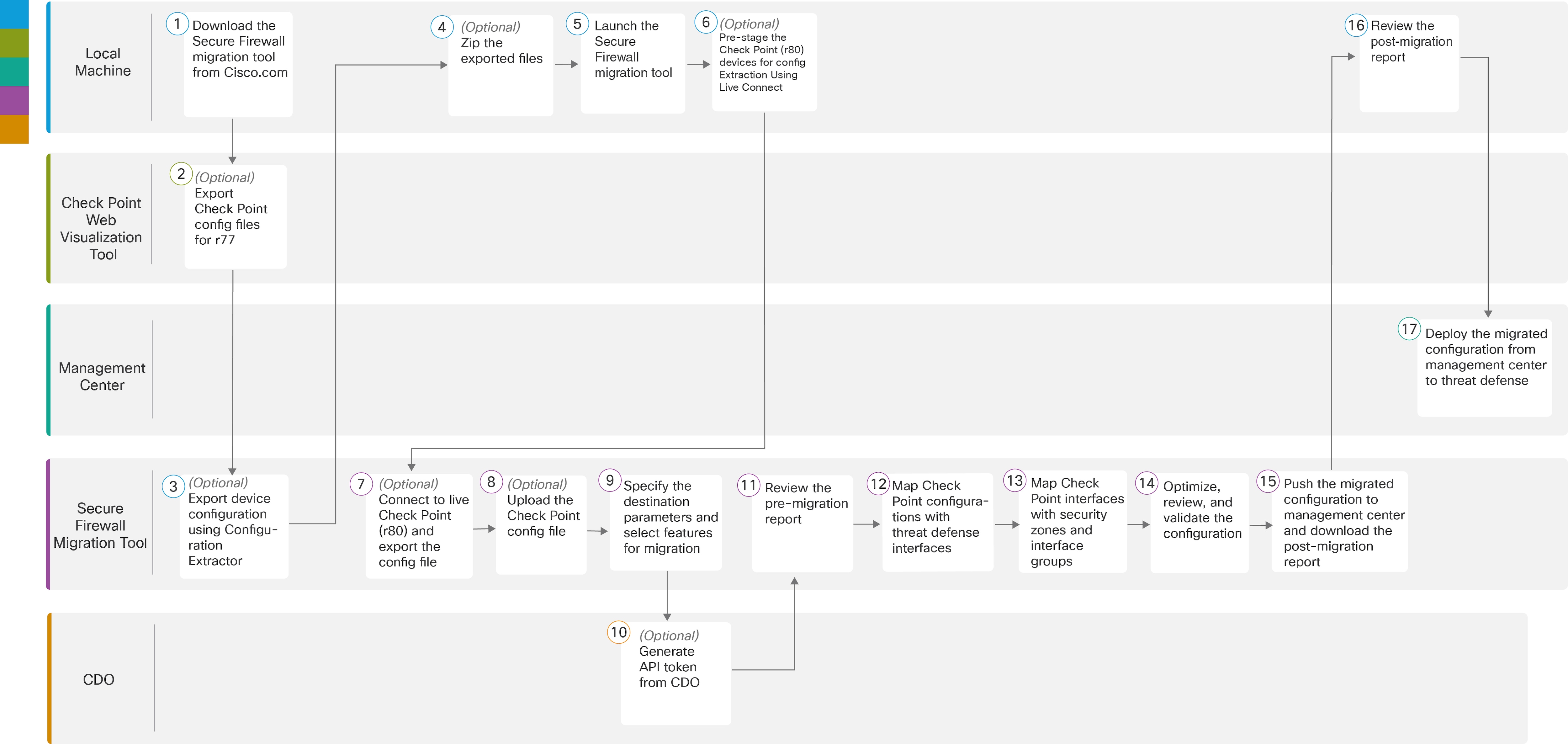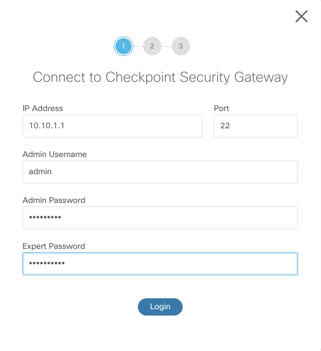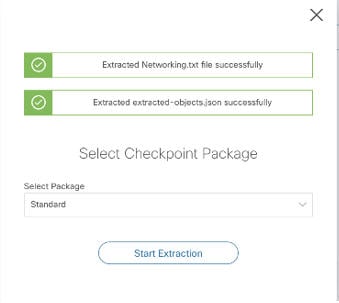End-to-End Procedure
The following flowchart illustrates the workflow for migrating a Check Point firewall to threat defense using the Secure Firewall migration tool.

|
Workspace |
Steps |
|
|---|---|---|
|
|
Local Machine |
Download the latest version of Secure Firewall migration tool from Cisco.com. For detailed steps, see Download the Secure Firewall migration tool from Cisco.com. |
|
|
Check Point Web Visualization Tool |
(Optional) Export the Check Point configuration file for r77: To export the Check Point configuration files for r77, see Export the Check Point Configuration Files for r77. If you intend to export configuration files for r80 using Secure Firewall migration tool live connect feature, skip to step 5. |
|
|
Local Machine |
Launch the Secure Firewall migration tool on your local machine and select Check Point (r75–r77) or Check Point (r80–r81) in the Source Firewall Vendor drop-down, based on your requirement. See Launch the Secure Firewall Migration Tool for more information. |
|
|
Secure Firewall Migration Tool |
(Optional) Export device configuration from Check Point (r75–r77): To export device configuration for r77 using Configuration Extractor through a secure gateway connection, see Export Device Configuration Using Configuration Extractor. |
|
|
Local Machine |
(Optional) Zip the exported files: select all the exported configuration files for r77 and compress them to a zip file. For detailed steps, see Zip the exported files. |
|
|
Local Machine |
Pre-stage the Check Point (r80) devices for config Extraction: You must configure the credentials on the Check Point (r80) devices before using Live Connect on the Firewall. For pre-staging credentials on Check Point (r80) devices, see Pre-stage the Check Point (r80) devices for configuration Extraction. This step is only required if you are planning to migrate configuration files for r80 devices. If you have planning to migrate configuration for r77 devices, skip to step 8. |
|
Secure Firewall Migration Tool |
(Optional) Connect to live Check Point (r80) and export the config file: To export the Check Point configuration files for r80 using live connect feature, see Procedure to Export the Check Point Configuration Files for r80. |
|
|
|
Secure Firewall Migration Tool |
(Optional) Upload the Check Point config file: For detailed steps for uploading Check Point Configuration file, see Upload the Check Point Configuration File. |
|
|
Secure Firewall Migration Tool |
During this step, you can specify the destination parameters for the migration. For detailed steps, see Specify Destination Parameters for the Secure Firewall Migration Tool. |
|
|
Security Cloud Control |
(Optional) This step is optional and only required if you have selected cloud-delivered Firewall Management Center as destination management center. For detailed steps, see Specify Destination Parameters for the Secure Firewall migration tool, step 1. |
|
|
Secure Firewall Migration Tool |
Navigate to where you downloaded the pre-migration report and review the report. For detailed steps, see Review the Pre-Migration Report. |
|
|
Secure Firewall Migration Tool |
The Secure Firewall migration tool allows you to map the Check Point configuration with threat defense interfaces. For detailed steps, see Map Check Point Configurations with Secure Firewall Device Manager Threat Defense Interfaces. |
|
|
Secure Firewall Migration Tool |
To ensure that the Check Point configuration is migrated correctly, map the Check Point interfaces to the appropriate threat defense interface objects, security zones and interface groups. For detailed steps, see Map Check Point Interfaces to Security Zones and Interface Groups. |
|
|
Secure Firewall Migration Tool |
Optimize and review the configuration carefully and validate that it is correct and matches how you want to configure the threat defense device. For detailed steps, see Optimize, Review and Validate the Configuration to be Migrated. |
|
|
Secure Firewall Migration Tool |
This step in the migration process sends the migrated configuration to management center and allows you to download the post-migration report. For detailed steps, see Push the Migrated Configuration to Management Center. |
|
|
Local Machine |
Navigate to where you downloaded the post migration report and review the report. For detailed steps, see Review the Post-Migration Report and Complete the Migration. |
|
|
Management Center |
Deploy the migrated configuration from the management center to threat defense. For detailed steps, see Review the Post-Migration Report and Complete the Migration. |









 ) to export the table to an editable Excel sheet.
) to export the table to an editable Excel sheet.
 ). The migration tool reads the entries in the Excel and automatically adds them to the corresponding preshared key columns
of the VPN configurations.
). The migration tool reads the entries in the Excel and automatically adds them to the corresponding preshared key columns
of the VPN configurations.
 Feedback
Feedback